What is wrong with QR codes?
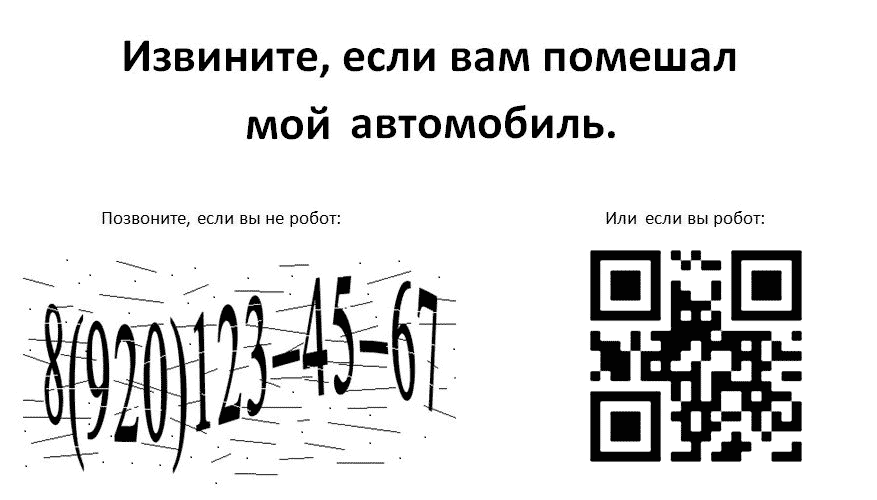
Beautiful picture of an unknown author
I have not written this article for a long time. For six months, I regularly practiced trying to go to the clinic to the doctors without a queue and boorish driving with Moscow numbers in the outback to become thick-skinned and immune to hate (even HATE !!!), which will spill on me after this article. This is inevitable, since Habr is a geek-oriented resource, and QR codes are geek technology. They have already received widespread and warm support from geeks Habr, so the future is in my gloomy shades. Do not be surprised at the razor blades in the mailbox and silent breathing into the handset from midnight strangers.
Apparently, for apologists of QR codes, this technology is an opportunity to bring the future closer, step into the wonderful world of tomorrow with the augmented reality of all these numerous videos and films about the future with transparent displays, something which can only be disassembled in the absence of translucent motley grandmother’s carpet on the wall. Geeks rejoice at any new example of using a QR code, even if it is children's pajamas with QR codes that help telling tales , tombstones , and cows . And with a dreamy look, they predict that in the future QR codes will be everywhere. In my opinion, this version of events can be described in anti-utopias, something like “We” Zamyatin.
')
To create the appearance of arguments in defense of my opinion, I could arrange a branch at wtfqrcodes.com here and with wicked comments, publish the most unfortunate and even dangerous cases of using QR codes, completing all this with a reference to understandable instructions . But this demagogy will not help to reach the goal - to understand the essence of the problem of QR codes, so passive-aggressive mod off, and let's see.

History, causes, scope
As expected, at first a bit boring intro with a well-known all the information. Barcode was invented (Morse code was the source of inspiration) for automating product labeling and subsequent reading of information by technical means. It is these functions that for many years have been gloriously performed by the EAN-13 format barcode, known to us as a “normal” barcode. Information for automation (stripes) is duplicated in a human-readable form (numbers).Such one-dimensional (linear) codes contain only a little information (up to 20-30 characters), and the geek-nation of the Japanese became indignant from the approaching buffer overflow and, in general, demand more! This is how two-dimensional (matrix) codes were born, the most popular of which was the QR code. Differences with a one-dimensional barcode:
1. increase the amount of information by a couple of orders of magnitude;
2. information is not duplicated by human-readable characters;
3. Clause 1 generates a small variety of formats;
I would say that the barcode stretched to the two-dimensional version remains the same barcode without any conceptual novelty, but all these Japanese schoolgirls decided that this was a fundamentally new technology, the new times came. Suddenly, QR codes decided to close the existing problem of the connection between reality and the virtual world. They have become inextricably linked with mobile phones and other gadgets, portable representatives of the virtual world during the journey of man through the real world. In addition to offline (billboards, posters, signs, press, urban surfaces,
So the technology of narrow professional use (logistics, production, trade) has become another way to throw a link to the seals, and this is veiled. Further, by airborne droplets or other unknown channels for the dissemination of insane ideas, this knowledge left Japan, and we got the world with QR codes, the most abused technology in the world.
What is wrong with them?
Passive and active reading
 With the new
With the new That is, in those areas where conventional barcodes are used (which, because of their routine, they do not have this flavor of innovation, “the future is knocking on our windows”), the use of QR codes is quite appropriate.
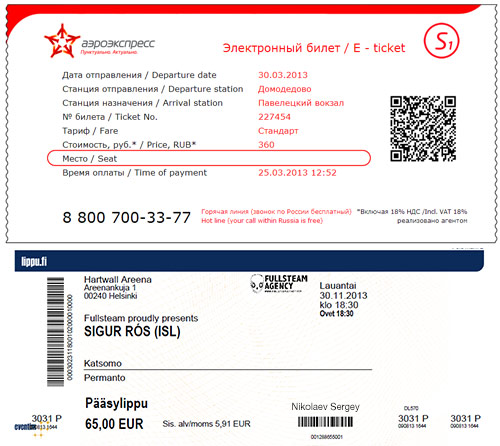
Aeroexpress and concert tickets are the right examples for using two-dimensional and one-dimensional codes.
Everything changes when the reading becomes active for the user. All care is shifted to the user: here's a pattern for you, think up something,
Technologies on the facade
If, when passively reading, the user may not even think about the existence of some code on his macaroni box, as this is not related to his service information, then, with active reading, the secondary element goes to the key place, and the person faces the QR code one. And then there is the problem of the essence of the QR code. In order to more clearly express the thought, I suggest making a flashback to the history of the relationship between a person and a computer.
Recall how people are different from computers. Computers do not tolerate inaccuracies, they are incredibly fast, they are not mistaken, pedantic, impassive, consistent, predictable and stupid. They are built on the framework of the binary number system and Boolean algebra. There is a current or not, 1 or 0, no doubt and intermediate options.
People are not like that. They are incredibly slow, wrong, irrational, emotional, chaotic, unpredictable and quick-witted. They are created from flesh, emotions, habits, mistakes, and delusions. Brain work is very different from the principles of computer devices. There are operations where a person can never keep up with a computer. In other directions, the computer is powerless in front of a person (remember the Turing test and your favorite captcha). And there are areas where we are lucky enough to observe a balance of possibilities for a while (let's say, chess). People and computers are VERY different. In this contrast, not only Azimov made a literary career.

Initially, a person had to communicate with a computer in his language, programmers worked with machine codes. However, people all the time trying to adjust the computer for themselves. Over time, these machine tamers made great strides towards building a high-level layer. From the deity to which they went to bow with sacrifices in the form of punched cards, the computer eventually became a slave to a person serving his whims (although iTunes users will challenge this statement, and I agree with them).
Gradually, due to the increase in computational performance, the development of the area of user interface design and the construction of new models (fuzzy logic, neural networks, genetic algorithms, etc.), the computer learns to communicate with people in the human language. And now he is trying to predict your behavior, remember your habits and preferences, corrects your mistakes, when you accidentally delete the wrong letter, recognize the commands given off by the drunken whisper, forgive you your leaky memory and beer belly. Monster tamed.
 There was always a feeling that if there are robots saboteurs among the human race, then these are Japanese, because the creators of the QR code brought us back decades and again put a person on his knees in front of the car. With active reading, people become the turnstile reading panel. The published QR code seems to say: “here's a two-dimensional matrix of bits for you, this is a very convenient format for the machine, let's decipher it. I don't care how you can on a piece of paper, you can look for a program . ” Instead of making the computer understand us, we again have to understand the language of computers. Here's a fiber optic cable for you, catch the flashes and write down on a piece of paper, this is your web page, then you will decode and read.
There was always a feeling that if there are robots saboteurs among the human race, then these are Japanese, because the creators of the QR code brought us back decades and again put a person on his knees in front of the car. With active reading, people become the turnstile reading panel. The published QR code seems to say: “here's a two-dimensional matrix of bits for you, this is a very convenient format for the machine, let's decipher it. I don't care how you can on a piece of paper, you can look for a program . ” Instead of making the computer understand us, we again have to understand the language of computers. Here's a fiber optic cable for you, catch the flashes and write down on a piece of paper, this is your web page, then you will decode and read.QR code is an inverted Turing test. Prove you're not human. Because if you thought of a QR code, then you either used the robotic part of yourself (a smartphone or another gadget), or did the
A century ago this was a necessity, people caught and deciphered the Morseian's ears. Now there is no such need (although in the Armed Forces of the Russian Federation they are still sitting, listening to all sorts of things - - - • and singing: “EEE-LOO-BEE check”). The format of providing information in the computer should not worry the user and in any way contact him. This is a business of professionals and geeks entertainment.
QR code and geeks
Geeks love QR codes, because they love to communicate with computers in their language. They try to understand the principle of the work of the things around them, they seek to control the world around and fine-tune it for themselves (one word “Linux” will be enough here) Geeks love when guts are out , when you can see how everything works.

(I’m talking about the third person geeks in the whole article, although the user himself is Miranda, FUBAR 2000 and this transparent card reader)
Even purely visual imitation of computers (high-tech style) is popular - on the Linux customizers website , this beauty is the second most popular with 768,865 downloads.
Geeks enjoy the understanding of the complexity of the system, for them in this complexity is their attraction. It is enough to recall the article about the manual decoding of the QR code. They enjoy the ordeal as a climber enjoys a difficult stretch that can only be passed on the edge of opportunity. They like to work in an environment where special abilities make them different. This happens in any professional community, there are different geeks. Assembly language programmers condescendingly refer to high-level freeloaders, filmmakers contemptuously look at digital cameras ( “press the button easily and in Lightroom move the sliders, but try reagents” ), and you shouldn’t even talk about the traditional humiliations of newcomers on the forums from old-timers. “A youngster, before asking, would first read 300 pages of technical documentation. On page 178 in Latin, everything is clearly written. ”
To show the difference between geeks and ordinary people (and help determine which group you belong to), we use the free interpretation of the aviation test from the magnificent book “The mental hospital in the hands of patients” by Alan Cooper.
Imagine that you are walking along the airliner landing corridor. Having entered aboard, you should choose - to go on the left to a cabin or to the right to the salon.

In the cockpit, there is a kaleidoscope of complex controls and counters, sensors, pens and toggle switches, there is control over the situation and the harsh requirements for understanding technology . In the cabin - soft chairs soothing beige shade, relaxation, refusal to influence the flight and thinking about the structure of the aircraft . If you (like me) feel a thrill in front of the dashboard of an airplane, you are a geek. There is nothing bad in it, this is great news, but we must remember that most people will choose the right turn.
People like new technologies. But ordinary people do not like when technology remains on the facade. They prefer the technology to remain hidden, under the hood. A man loves magic, magic, when technology is not visible, but it works. When they do everything for him and quietly, without bothering with unnecessary questions and demanding an understanding of the principles of work. “Any sufficiently advanced technology is indistinguishable from magic,” states Arthur Clark. As a result, any technology that is distinguishable from magic is not sufficiently developed.
The door handles of the Tesla S are magic (go, “Scan this QR code so that the door opens”). When Google.nau scanned the mail, found an e-ticket for the plane and reminds you of the upcoming trip - this is magic. When the phone is unlocked, recognizing the appearance of the owner - it is miracles. Even the plane, as you know , is magic, because the passenger is closed from the cabin by a thick armored door (and from the knowledge of aerodynamics by the years of the humanitarian university).
Ordinary people do not like postal codes, they are constantly confused and forgotten. Ordinary people do not share ISBN book numbers instead of the name and name of the author. Ordinary people change the address of their social network page from id12345678 to lenusik1985. And yes, ordinary people set passwords password123, not + N] L2.MK`Gle ~ P.0SY? P9eA; @y |. Because ordinary people understand and remember what makes sense to them, and do not dull into what was created for the robot, and not for humans. And the QR code is the highest manifestation of a thing created for a robot, not for a person.

Original Mondrian, if anyone is interested
QR code is unintuitive and incomprehensible. Damn, this is a mosaic in the form of a set of bits! It is obvious that a person who knows nothing about the QR code cannot even understand what this thing is. Solved Japanese crossword? Labyrinth? Rebus? Modern Art? Is something broken? Any service information for men from a water utility? Optical illusion? Secret military cipher? Korean alphabet? Map of San Francisco? (these are real people's assumptions ). It could be anything. It is impossible to guess. Therefore, an impressive amount of instructions appear, against which the last item “or just type apps.yell.com in the browser” looks like a gift from heaven. Even marking distances to manholes makes more sense for the average person; at least the numbers are familiar there. Would you even show the session identifier in the browser to the person or suggest storing cookies in a notebook. This information is not intended for the general user.
Like everyone, geeks tend to hang out among their fellows. With the accumulation of a critical mass of geeks, it begins to seem to them that everyone is just like them, smart and advanced. That things that they understand are obvious to the rest. They forget about the existence of ordinary people. This is Silicon Valley Syndrome. The cry of ordinary people does not go through a thick layer of advanced guys surrounding the developer. Technically uneducated people do not become a source of inspiration for developers, but the subject of jokes about IT happens (when I hear another such stead of the administrator’s account about an accountant who claims that he has broken the Internet because he accidentally deleted the browser shortcut, I’m imagining this admin in the pharmacy confused Furazidine with Furazolidone, and in the evening the pharmacist on the pharmaceutical forum in the corporate echidny style of such resources shares this story with his colleagues with the conclusion “what are all stupid”). As a result, ordinary users fall victim to apartheid tech-savvy guys . A QR code is a great example of this. As for the Japanese, whose QR codes are extremely popular, then I cannot boast ethnographic knowledge, but according to the general signs of turning on fancy technologies (it is worth remembering their toilets with dashboard that can decompose waste products into a Fourier series), we can conclude what is a geek-nation.
UPD: The comments more convincingly explain the reasons for the popularity of QR codes among Japanese.
And, by the way, another indicator of the QR codes' geekiness - try to find a QR-scanner with a good interface and a nice icon in App.Store. When you type “QR” in a search, a
Humanization?
Lingering attempts to powder the monster and make QR codes closer to the people boil down to worship .
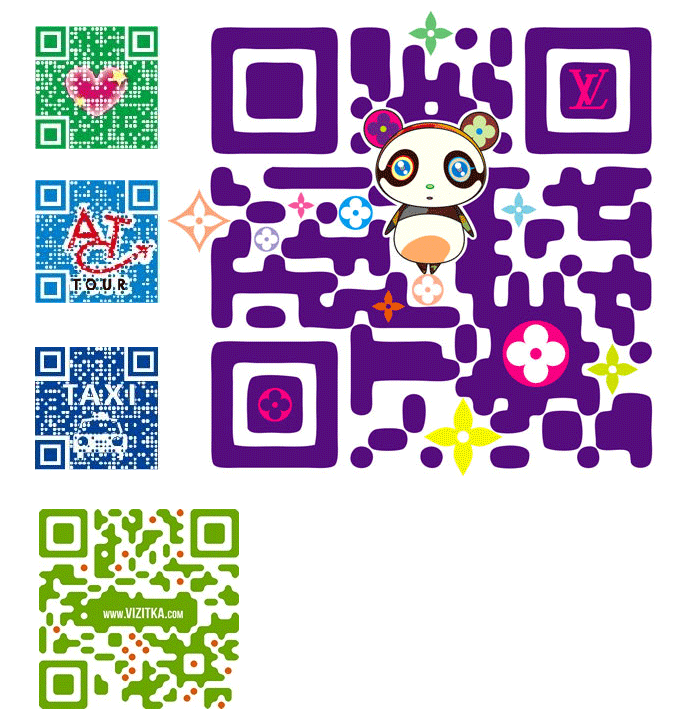
 Sorry, straziki and unicorns lost on the road .
Sorry, straziki and unicorns lost on the road .The website of business card. Com says that “QR-code is QRuto” ,
Graceful degradation
Any web technologist knows what graceful (elegant) degradation is . This is a technique where, for outdated browsers, instead of the big banner “IE6 MASTDAY, INSTALL NORMAL BROWSER OR KILL YOURSELF,” a simplified page is provided, probably less convenient and not very elegant because of the inability to use all the most advanced technologies, but still functional. The user receives the level of service in proportion to his advancement: if you have the latest Chrome, you will receive a service at the highest level with autocomplete forms, ajax-upload and trendy parallax ryushechkami; if the old Donkey has js disabled, then only the option to submit the form. The bottom line is to try to do at least something (even if it is ugly and poor) for all categories of users, and not to declare once the category of users “not sufficiently advanced to use it”.
If we translate this terminology into our history, then the usual one-dimensional barcode satisfies this approach. Even professional equipment can not always read the barcode, which we all witnessed at the checkout of the self-service store, and in this case the standard duplication of information with numbers comes to the aid of cashiers: the item number is clogged on the keyboard. In addition, even without a scanner, we will be able to extract useful information from the EAN-13 barcode (for example, find out the country in which the goods were produced by the first numbers).

QR codes divide all people into two numerically unequal groups - either you have a smartphone with a camera and (pre) an installed application that recognizes the code, or you are in a span. Grandmothers, people with ordinary mobile phones, with a dead smartphone or without an installed application - sit on the redraw pattern if you want to at least understand what this QR code is all about.
Alternative, present and future technologies
What can be advised to use instead of QR codes?To begin, remember what information can be encrypted in them. The QR code specification does not describe the data format, therefore, in fact, QR codes are pushed into everything that fits into 4kb, mainly numbers and letters (text, links, browser tab, Email (with the letter subject), SMS to number (c topic), MeCard, vCard, geographical coordinates);
In TRIZ (Theory of Inventive Problem Solving ) there is a concept of an ideal object : “An ideal object is when there is no object, but its function is executed” . Idealization of the system is achieved by reducing individual parts of the system by eliminating redundancy. For example, on sites, the checkbox of the login form “do not remember me” (aka “someone else’s computer”) is redundant, since it duplicates the universal “tab incognito” option, which is supported by all modern browsers (including mobile). So, to solve the problem of a QR code, we have to make it so that it does not exist (for the user), and its function is performed. I see two possible solutions, the combination of which completely overlaps the problem: recognition and non-visual tags.
Recognition
The toolkit is pretty simple: it’s a shortcut reader , a gadget camera, and an image recognition application . The principle of operation is even simpler: publish the information itself, and not its encrypted version. Text? Link? Contact details? Picture? Just publish them in their original form, the most convenient for a person without any gadgets. . .
, Google Goggles . , , ., . . + + OCR , :
— DVD ;
— QR- ;
— ;
— ;
— ;
— ;
— ;
— ;
— ( ) ;
— , , , ..;
— , .
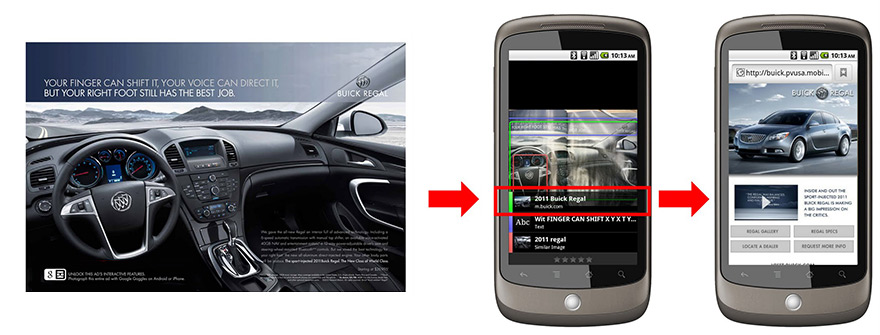
: Goggles , - .
, . « » — , — ( ), — . (, ) , -, . , . - , « », , , ( ) .
. QR- — . . ( , , ) , ( New York Times — nyti.ms, Wall Street Journal — wsj.com, Time Magazine — ti.me).

. ? , . , .

, , QR-:
:
— Goggles ;
— , ;
— , .
, , . QR- , ( Goggles), , - . «» — , , .
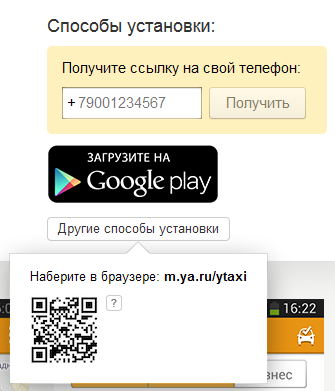 QR- . , ( , - ). ( , ) , : . , . , instapaper , readability pocket .
QR- . , ( , - ). ( , ) , : . , . , instapaper , readability pocket .— , . , QR- . , , , , , . , , , , .
, . , , . : , , — , , , , .
, .
NFC (, ). ( 10 ), . , ( , NFC ), . NFC , -, 5 . NFC- , , NFC.
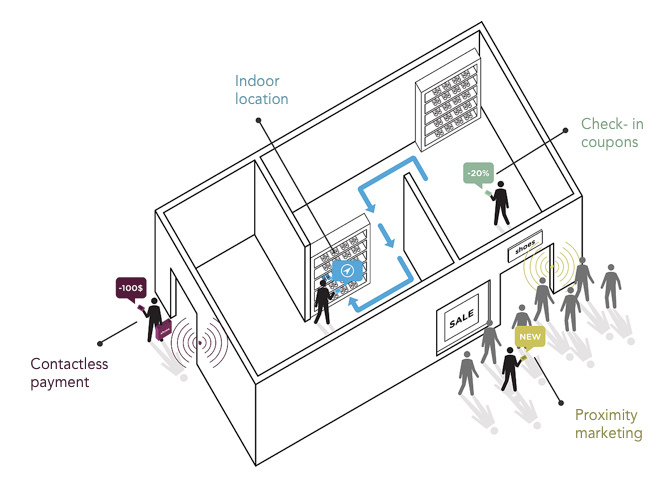
( , )? , iBeacon (i) — , . , - (Indoor positioning system), . ( Bluetooth low energy) ( ) , , . iBeacon ( , - 30$) — : , , , , , , .
iBeacon, , WiFi- , WiFi-.
QR-
1. On the business card of the president of the company DENSO WAVE INCORPORATED . And also on his car, on clothes, on wallpaper, on domestic animals, on children's pajamas, on the children themselves, on a photograph of the wife who packed up and left with marked children to live with her mother. He can, this is his job.2. In some advertising campaigns. When it is necessary to intentionally create intrigue, minus QR codes can be turned into a plus. Their merciless incomprehensibility and the impossibility of finding out anything without decoding generate burning curiosity among geeks. Smart viral marketers have scanned and published QR codes of gigantic sizes for zamanuhi without any explanation. Geeks accept the challenge and are eager to recognize. Well, you know, these are hacker logical quests, 4 characters are given, and you have to guess to transfer them to octal numbering system and use the resulting numbers as a port that you need to knock on a server whose address is obtained from the sum of the second and third elements of the Galois field, dimension which you can get if ...

3. To identify among geeks "friend or foe" such a certain coming out. Well, there is a screen on a T-shirt (so that everyone would feel embarrassed when someone decides to consider it), put it on an avatar. Let everyone know, I have nothing to be ashamed of!
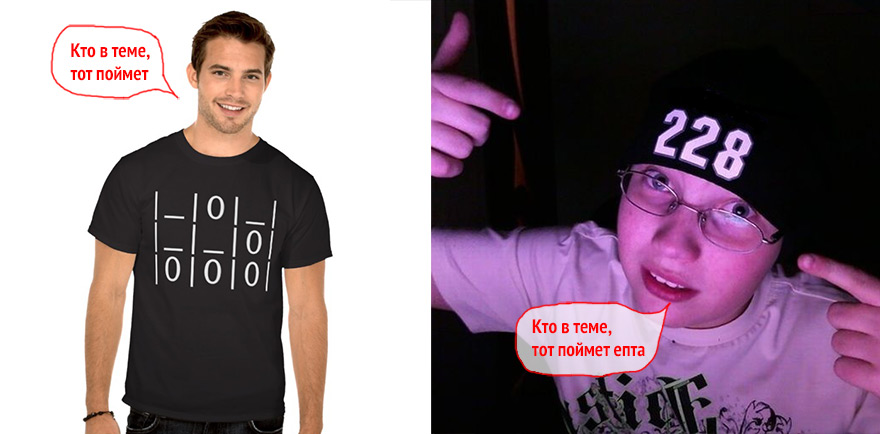
4. Again, if you are any experienced bearded gentleman and imagine the miracles of reverse engineering on turns, feel free to write down the QR code with working contacts throughout your home page - you are clearly not interested in people who do not know what it is such No need to think how a neighbor's grandmother can read it, such people are strangers here. At all sorts of hackathons and specialized conferences, you can refuse from any means of presenting information, except for QR codes, only please the corresponding public.
5. As a possible update where ordinary barcodes are used, i.e. with passive reading.
findings
1. QR code is the same barcode without any conceptual novelty, only with increased volume and without duplication of information with symbols. If you want to mark the QR-code, imagine a usual barcode on this place and think about whether it looks crazy.2. A QR code is quite a solution when passively reading, i.e. in areas where a conventional barcode is used;
3. QR-code is an incomprehensible, unpleasant, but useful way of communication between the real and virtual worlds, which are extremely abused;
4. QR code - dead-end branch of evolution; instead of serving the computer to a person, talk with robots in their language; instead of graceful degradation, a
5. QR code - a patch that has an alternative in the present and future;
6. The QR code will remain as geek-fun and secretly spread into the geek-ghetto of the future, if they don’t come up with any new entertainment by this time, such as transferring data via the Rubik’s cube;
7. For God's sake, if you still want to publish QR codes, duplicate the information.
If even shorter: technology must adapt to a person, not a person to technology .
PS: Traditionally, I apologize for the scholarship, offtopics and abundant water.
UPD: Naturally, many Habr's readers are comfortable using QR codes, which they tell about with life examples in the comments to this article. That's why it is Habr.
Epileptic gift for last

Source: https://habr.com/ru/post/206924/
All Articles